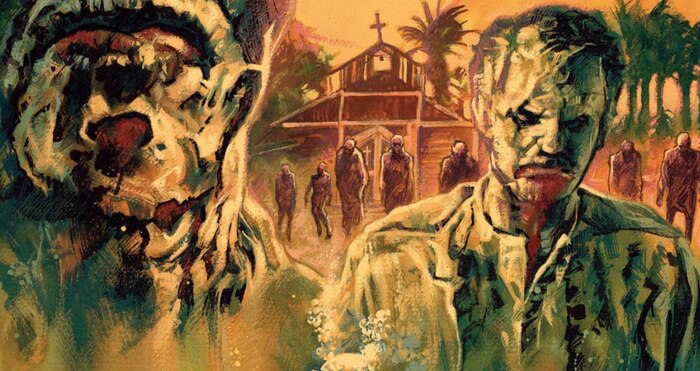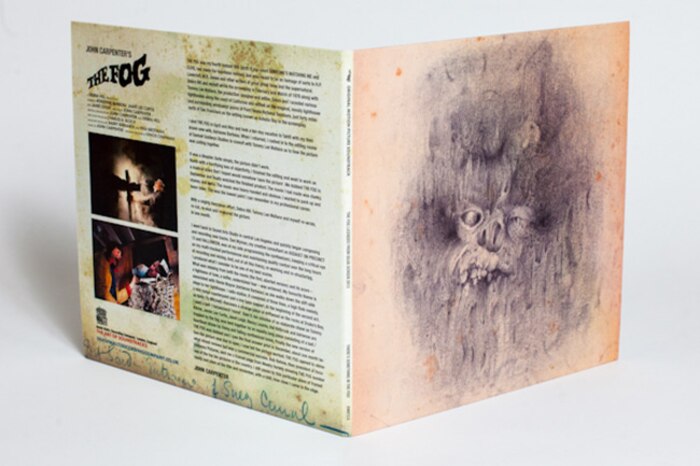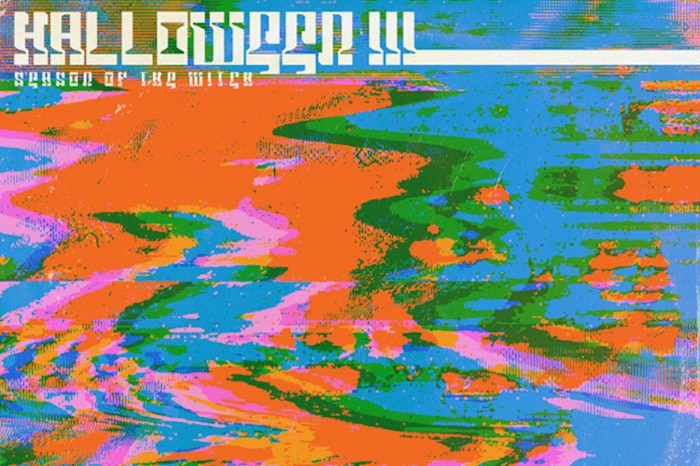Interview: Death Waltz’s Spencer Hickman on Soundtracks, Art, and Reissue Culture
A chat with Spencer Hickman, the man behind the world’s spookiest soundtrack and reissue label.

Before Death Waltz Recording Company was founded in 2011, Spencer Hickman was running Rough Trade East on Londond’s Brick Lane and coordinating Record Store Day UK. But since starting his boutique soundtrack label, the hobby has grown into a full-time concern, operating across the Atlantic in London and LA. Working closely with legendary composers and directors such as John Carpenter, Richard Kelly, Alan Howarth and Fabio Frizzi, Death Waltz creates definitive audio re-masters and sleeve notes, and also commissions designs from such acclaimed artists as Dinos Chapman, Graham Humphreys, and Candice Tripp for each project.
With careful attention to detail, Death Waltz has established itself as the premier soundtrack label in cult films, pressing their releases on heavyweight vinyl and supplying exhaustive liner notes and detailed posters and prints. Death Waltz challenges the prejudice that cult soundtracks are just for a niche audience of film students: it’s become an archive of the weird and wonderful, and a touchstone for composers and filmmakers who want their work released in the highest quality. In this edited and condensed excerpt from his recent interview with RBMA Radio, Hickman offers an insight into the label.
The very first time that you reached out to a director or to a composer of a film score. How did that work out?
Fabio Frizzi, who’s an absolute legend of Italian cinema music, scored Zombie Flesh Eaters, which when I was a kid, was one of my favorite films. He was so over-the-top. I remember asking the person that owned the rights to it, if I could license it for vinyl, because it was out on CD. It had never come out on vinyl. They were like, “Yeah, cool.”
I think they put me in touch with Fabio, and I got an e-mail back from Fabio and he was like, “Oh my god, you’re crazy. Who wants to buy this on vinyl?” Myself and Fabio have become really good friends over the last three years.
John Carpenter’s given us sleeve notes for Escape from New York and Prince of Darkness and all this stuff. It’s pretty nuts, to be honest, when you think; these are my childhood heroes. They’re not people that I just admire. They’re people that shaped who I am, I suppose. To be able to talk to them, and work with them; you’re talking to them as a fan, but you’re working with them as an equal.
The people that buy your records, are these mostly people that would know the movies, or is it also people that really just are into the music?
It’s a weird mix. We pressed 500 copies of Zombie Flesh Eaters and Escape from New York, and we sold that in a day, which I couldn’t believe. It was just crazy. I knew that I wanted these things, but I didn’t know how many other people would want them.
I didn’t know if people would like the re-imagined cover art. That was my key thing: I didn’t want to do the same existing poster artwork for the records. I wanted to create something that was new. I wanted the main focus to be on the music as well, because it’s always on the film and the music’s always a secondary piece of the art. The versions I’ve got of John Carpenter’s Escape from New York were not great. They were definitely afterthoughts. I wanted to make sure it was front and center about the score, and the art was to accompany the score, not the DVD or a theatrical re-release.
But then there are a bunch of people who don’t care about the fact that it’s a movie. They don’t care about the fact that there’s no artwork. They just want the music. We were in a record store in California called Poobah Records. They get a huge amount of hip hop DJs, and all those guys were saying that all the DJs had come in to buy our records, because there will be a break on there, and there will be some kind of weird track on there; maybe something they can use. I’m really lucky that the label has appealed to a huge cross-section.
When you go hunting for a soundtrack, is it usually a movie that you’ve watched over and over?
I have a massive list of stuff I want to release. We get newer stuff we get offered as well. People out there come to us and ask us if we’re interested in releasing their film, which is really cool. That’s what makes the label great. It’s not a reissue label, though people class us as a reissue label. We released The Devil’s Business, Room 237, Maniac. For me, it’s got a good mix of both contemporary and classic scores.
Being stuck in nostalgia, I don’t think that’s an approach that works.
It doesn’t serve you for the future, because there are only so many old soundtracks. Now, with the glut of soundtrack labels that have sprung up in the last two years, everyone now seems to be vying for the same title. I’m quite happy to walk away from that.
For those who aren’t aware, could you explain the video nasty phenomenon?
Video nasties were… it’s become this weird scene, and it wasn’t that. They were just always films that were lumped in together, when videos first became really readily available at home. You could go down to the video store and you could rent Cannibal Apocalypse, Cannibal Holocaust, Last House on the Left, at any age. We were like 13, we’d bunk off school, and rent all these things.
Somebody in the conservative government saw these films and thought they were outrageous, and thought they were going to destroy Britain’s youth; destroy our minds and turn us all into serial killers. They started to ban them, and they started to put people in jail for renting and selling them. It’s become this big thing, the video nasty. You kind of wear it as a badge of honor, if you lived through that time.
Could you imagine releasing scores for films where you actually don’t like the film that much?
No. I still have to love it. I don’t think I’d want to get to the point where I was just going, “Go on, we’ll release this because we need to release it.” I’d rather take six months off, and find something that I want to do. You have to be into both of them, otherwise it just doesn’t work. It’s the same as finding the artists to do the cover art for it. I’ve got to be into them. I buy a lot of art, and I’m interested in different artists, not just the current crop of guys, which is why we’ve managed to get Dinos Chapman to do a cover of The Fog for us, which was amazing.
I think, for the label, working with Dinos was kind of a really pivotal moment. It’s where kind of everything collides perfectly. Basically, when John made the film, they watched it, and it was a disaster. He was really unhappy with it, so he went away and re-cut it, and then re-scored the whole movie. So the first disc is the actual released version of The Fog, and the second was all the original cues. Lots of them were unused, because they were from the first version. It was a pretty huge thing to get.
I sat at home in tears, because nothing was working. I could see everyone getting frustrated, and I’m trying to man Twitter, Facebook and answer e-mails.
John had given us sleeve notes. I had a friend who said, “I was talking to Dinos Chapman at a party the other day, and he’s really into horror films. He loved The Fog, and he’d love to do a cover for you.” It’s one of those conversations where you’re like, “Yeah, I’m sure; whatever. He’s one of the most famous British artists of our generation. Yeah, cool, whatever.” Weirdly, they put me in touch with a gallery owner that was friends with him. Before I knew it, I was going to his workshop to meet him, with a pile of records, showing him stuff that we’d done.
He’s really into weird electronic music, and we ended up comparing titles and what have you and he was like, “Yeah, I’ll do it.” I was like, “Really? That easily?” That was the first time I realized how big the label had become. Due to our licensing deal, we were only allowed to press 700. It crashed our Web site. It was pretty horrific, actually, because we had so many thousands and thousands of hits and refreshes. The Web site collapsed under the pressure. We just didn’t realize how big it was going to be. Lots of people were really not very happy with us. I sat at home in tears, because nothing was working. I could see everyone getting frustrated, and I’m trying to man Twitter, Facebook and answer e-mails. Everything’s just dying. We managed to repress it and did a different version, and made everyone happy. That’s when you suddenly realize how big it’s become, from this little hobby label into a respected label.

That’s usually a decision you make because of licensing, or is it also you wanting to limit it?
This is weird, from someone who works in record stores their whole life, but I don’t like the snobby aspect of record collecting. Music is really inclusive. You don’t have to buy music to like music. You don’t have to buy it to appreciate it. It doesn’t make you a bigger fan because you own every record that’s ever been pressed by the band. You could own none and still love them.
I don’t like that kind of inherent snobbiness that can come with record collecting.
I don’t like that kind of inherent snobbiness that can come with record collecting. It’s pointless. I am a record collector, but there are different levels of how people treat other people. The idea was that we would always do a limited version, for hardcore fans. I am one of those people as well. I get angry if I don’t get what I want, because the Internet has bred this kind of culture of “I must have it. I deserve it. I’m a fan.” We all want to get the limited stuff, and it’s all cool when you do.
I also wanted to create an edition that was just there for people to buy. You could buy Zombie Flesh Eaters in a shop, three years down the line. Even if we’re only selling ten a month, it doesn’t matter. It should be in print. Also, I want to encourage people to buy vinyl. With the vinyl resurgence, it’s really funny. There’s a lot of newer labels who I don’t think get it. They want to release things and then never make them available again. Why would you want to alienate fans, or people that want to collect? That’s really weird. That’s great for them, but it’s not great for me. As I say, music is the one thing that you don’t need money or possessions to appreciate. That’s a really cool thing, and super hippie. I hate hippies, but that is just the truth.
Do you think there are any cultural reasons or something in the way the industry was set up that made Italy so special in terms of these soundtracks?
I don’t know why Italy was a hotbed for crazy filmmakers that would let crazy composers do whatever they want. I don’t know if it was down to money. I don’t know if it’s a cultural thing. Talking to some people that have released on the label, they say at the time, the Italian film industry was in fairly rude health, but it was very highbrow.
These movies like Zombie Flesh Eaters or Zombie Holocaust could be released fairly quickly. The big thing with Italy was, if something was a hit in the US, they could churn out a semi-sequel to it within a couple of months and people would just eat it up. Those didn’t cost a lot of money. I think maybe it’s because of this that composers were just given free rein to do whatever they want to do. I’m assuming they worked quickly on these slasher movies, and they worked with whatever they had. They seem to have just been given sort of free rein.
How do you feel about using actual actors’ voices in released soundtracks?
I’ve got a weird thing when it comes to dialogue on soundtrack albums. I’m not massively a fan, unless it really works within the music. I’m not a huge fan of just having dialogue segments between tracks. It kind of detracts from the music. It then sort of pushes it back to “this is a film soundtrack,” as opposed to “this is a piece of music, a suite of music to listen to.”
We do, at the beginning of They Live, have some dialogue. It’s really integral to the movie, and the opening theme as well. In our release of Ti West’s The Sacrament, Ti and the composer, Tyler Bates, made the decision to mix in certain lines from the film within the score, because they felt it really fit. That’s their vision, and I do actually like that, because it’s part of the music. It’s almost like a sample.

Can you talk a bit about Jay Shaw, who has done some of the artwork for the label?
Sure. With Escape from New York it would have been so easy for us to go, “This is our first release, we need to play it really safe with this. We’ve got to have Kurt Russell on the cover.” Jay turned in this cover, which is bonkers, but it’s amazing. When you look at it, it’s got all the elements of what makes the film “Escape From New York,” but they’ve done it in such a way that the stuff is disorienting, and you don’t know actually what’s what.
I’m really a big fan of artists that can do that. I really love traditional stuff as well, like obviously Graham Humphreys. He’s the guy who did all the original posters for Evil Dead and Nightmare on Elm Street. He’s super-famous. He’s done a bunch of covers for us. His use of color is just like no one else can touch him. I like to mix it up.
Jay is the one artist you’ve worked with the most, right?
Jay and Graham. I don’t just get an artist because I need an artist. I really try and match them up to the record. Jay, though, comes at things really differently. If you like Halloween III and you know that movie, you immediately get the image that he’s related to the film. Jay took a photograph of his old VHS copy of a pivotal scene in the movie playing on his TV. He opened the JPEG up and text edited it. He took out a line of the text, replaced it with the final line of the film, and then reopened it as a JPEG, and it came out as this kind of super-blurry TV, static-y image, which absolutely suits the film. Just the thought process of doing that, is incredible. His mind works differently, and I like that. I always encourage him to just go crazy.